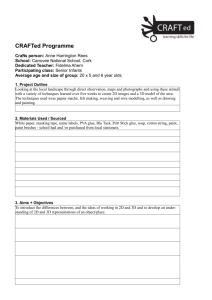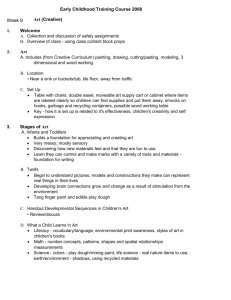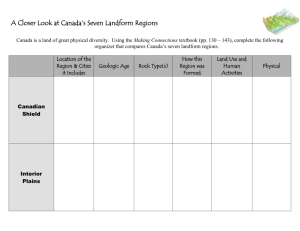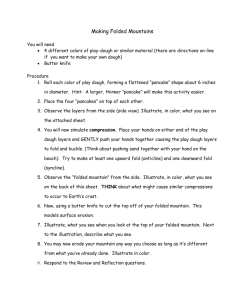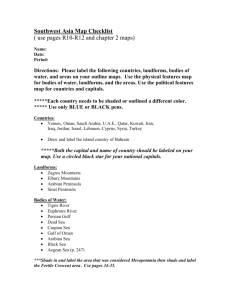Social Studies Landform Project
advertisement
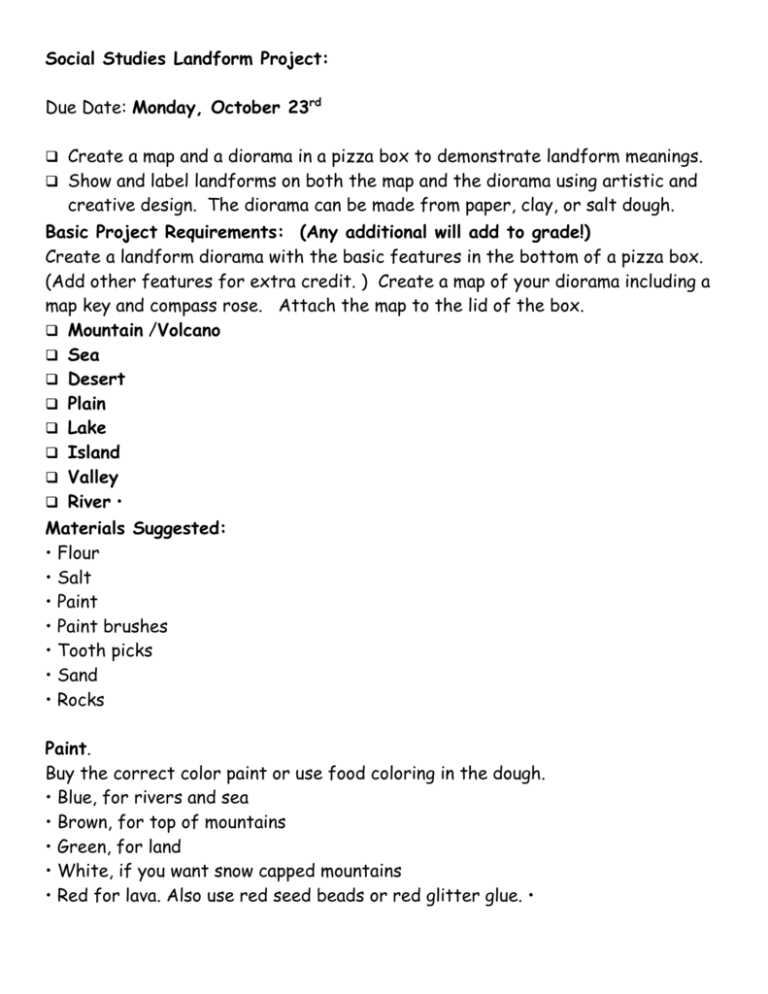
Social Studies Landform Project: Due Date: Monday, October 23rd Create a map and a diorama in a pizza box to demonstrate landform meanings. Show and label landforms on both the map and the diorama using artistic and creative design. The diorama can be made from paper, clay, or salt dough. Basic Project Requirements: (Any additional will add to grade!) Create a landform diorama with the basic features in the bottom of a pizza box. (Add other features for extra credit. ) Create a map of your diorama including a map key and compass rose. Attach the map to the lid of the box. Mountain /Volcano Sea Desert Plain Lake Island Valley River • Materials Suggested: • Flour • Salt • Paint • Paint brushes • Tooth picks • Sand • Rocks Paint. Buy the correct color paint or use food coloring in the dough. • Blue, for rivers and sea • Brown, for top of mountains • Green, for land • White, if you want snow capped mountains • Red for lava. Also use red seed beads or red glitter glue. • Other Supplies. • Pizza box, or box of similar size. • Cardboard base, slightly smaller than the bottom of the box. • Paper cup to mix sand and glue. Salt Dough Recipe 2 cups white flour 1 cup salt 1 cup boiling water 3 teaspoons of vegetable oil Mix flour and salt Add boiling water and oil. Stir with a spoon. Knead when it is cool. Store unused dough in a sealed plastic bag in the refrigerator. Let it warm to room temperature before using it. Take only what you need and leave it in a sealed container when you are making your project. There are several types of landforms located around the world. Landforms are included in ecosystems such as the rainforest, tundra, desert, forest, grasslands, and oceans. Each ecosystem has landforms with unique characteristics. Choose landforms that naturally occur in your chosen ecosystem. For instance, prairie landforms would not be found in a rainforest! Remember to make a map key! Use plastic toys and dolls to add interest to your landform diorama! Assemble: Dough. Mix the dough. Two cups of flour will be enough to make three mountains and the plains for a 12 x 12 landscape (30 x 30 cm). Draw Map. Draw a rough map the same size as the base of your box. Copy this map on the cardboard that will be used for the base. It will be used to guide you in painting and placing your features. Do not create your project in the box. Decide where "North" is located. Next, decide where to put these features in this order: Mountain, sea, desert, plain, lake and Island. The valley is between the mountains. Draw a curving river from the mountain, through the valley and down to the plain and into the sea. Mountains. Mountains should not be taller than 6 inches (15 cm). For mountains higher than two inches (five cm), make a cone by folding a piece of cardboard. Staple and tape it. Stuff with paper. Make sure that it can stand upright. Roll a piece of dough flat and cover the outside. Place it on the base and arrange all the mountains together. Then fill in the spaces between with dough until you have shaped your mountain. Volcano. Make sure that there is a depression in the top. You can even place a straw or tube in the center for a central vein. Valley. The valley is automatically formed between two mountains. Fill up the space between the mountains from the base at least an inch (2½ cm) Plains. Fill in the spaces between the mountains and the valley, following a gentle slope down to the sea. Use small pieces of dough and press them in or spread them with your fingers. Use the boundary lines of the map to know where to place the dough. Do not cover the sea, lakes, ponds or the desert with the dough. River. Draw the main river in the soft dough. The tributaries can be painted following the natural curved lines created when you made the plains. Labels, Trees and Accessories. While the dough is soft, use a toothpick to poke deep holes into all the places where trees or labels will be placed. Accessories. If you have miniature items like animals, put them in the soft dough so that they will make a permanent mark where they will be placed. Remove them and leave the holes to dry. Let it dry over night. If you allow the dough to dry before making all your holes, then add more soft dough and paint. Insert your trees or other items and allow to dry. This reshapes your landscape, so be careful. Green. Paint all of the dough green for land forms. Do not worry about going over the edges. Let it dry. Dab light green paint on the dark green to simulate grass. Brown. Paint the tops of the mountains brown or white. Blue. Paint the sea and lake on the cardboard or glue blue paper. Paint the rivers or use blue glitter glue. Coast Line and Beaches. The sand will be used to hide the imperfections in your painting between the water and the land. Mix glue and sand. Pour on the edges. You can add sand over this to give a more natural look. Use a stiff brush to sweep away the excess sand. Use tiny brush strokes to remove sand. Desert. Glue sand to the bottom. Pour loose sand on top to get a more realistic effect. Volcano. Use red glitter glue or, mix sand, glue and red paint. Squeeze out of a tube or pour on the top and let it slowly run down. Pour it only on one side if you want the lava to flow only from one side. Stretch out a cotton ball so that it is thin. You can use a it to simulate smoke coming from the mountain. Glue to the top or to a tooth pick so that it rises a little above the top. Map. Use the rough map to draw your finished map. Your map should have the following: 1. Color with construction paper or colored printer paper. 2. Map key 3. Compass Labels. Make labels. Cut along the solid lines. Fold the label in half at the dotted lines and glue a toothpick behind the dotted line. This creates a label that can be read from both sides. Accessories. Place your miniature items in the locations that you have created for them. Box. 1. 2. 3. 4. 5. Cover or paint the box so that it looks attractive. Attach the map to the lid of the box with a glue stick. Attach the labels with your name and the name of the landform. Insert your three dimensional landform. Add the labels for your features and any miniature accessories. Suggested Landforms: Note- These vocabulary words will be on an end-ofunit matching test! Students should study all meanings! Continent. A large continuous land mass. Island. A piece of land surrounded by water. Desert. A hot, very dry, treeless area that is usually filled with sand. Tundra. A cold treeless area. Forest. A large area of land with many trees. Garden. A formal and artistic arrangement of interesting plants and flowers. Archipelago. A group or chain of islands. Atoll. A ring of coral that forms an island. Plain. A large, flat area of land in the low lands with mostly no trees and minor changes in elevation. Prairie. A wide, flat area that has grass and a few trees. (See plain) Crater. A large depression in the earth caused by the impact of an asteroid or other object from space. Isthmus. A narrow strip of land that connects two land masses and has water on each side. (See strait) Coast. The boundary between the land and the sea. Beach. A wide, flat area of sand that covers the coast. Delta. A low watery land at the mouth of a river. It is usually shaped like a triangle. Wet land. An area of land that is often wet. (e.g. swamp, bog, marsh, moor ) Cape. A pointed piece of land that sticks out into a body of water. (See peninsula). Peninsula. A large body of land that is surrounded by water on three sides. (See cape). Mountains and High Lands Mountain. A land that is raised above the surrounding area. It is over 2000 feet (610 m) high. Volcano. A cone shaped mountain or hill built around a vent that connects it with reservoirs of melted rock below the surface of the earth. Hill. A landform that is raised above the surrounding area, but is smaller than a mountain. Plateau. A flat open country in the high lands. Dune. Temporary hills of sand shaped by the wind. Cliff. A vertical rock exposure. Butte. A rock or hill formation with a flat top and steep sides. (See mesa) Mesa. A land formation with a flat top and steep sides in a dry area. Valley. The low areas between two elevations. Canyon. A deep valley between high cliffs or formations with steep sides. Water Ocean. A large body of salt water that surrounds a continent. Sea. A large body of salt water that may be partly or totally surrounded by land. Lake. A large body of water surrounded by land. Pond. A small body of water surrounded by land. River. A large, flowing body of water that empties into the sea. Tributary. A stream or river that flows into a larger river. Glacier. A slow moving river of ice. Lagoon. A shallow body of water along a coast. Gulf. A part of the ocean or sea that is partly surrounded by land. Bay. A small body of water that is partially enclosed by land. Fjord. A long narrow sea inlet that is bordered by steep cliffs. (See canyon). Sound. A wide sea inlet that is parallel to the coast. It is usually between the coast and an island. (See fjord). Channel. A deep and wide strip of water that separates two larger bodies of water. It is usually part of a river. (See strait). Cove. A small, horseshoe shaped body of water on a coast. Strait. A narrow body of water that connects two larger bodies of water. It has land on both sides. (See isthmus) Swamp. Fresh water wet land with very muddy, spongy land. Marsh. Salt water or fresh water wet land that is found beside rivers, lakes and coasts. Source. The beginning of a river. Map Example Grading Rubric Exploring Landforms Project Rubric Student's project includes diorama and map _____ Student's project correctly represents landform types _____ Student’s project includes all required basic landforms _____ Student's project includes more than basic landforms ______ Student's project shows effort with neatness_____ Student's project shows creativity in project _____ 3=Wonderful effort 2=Satisfactory effort 1=At least I tried 0 = Did not attempt Total __________

